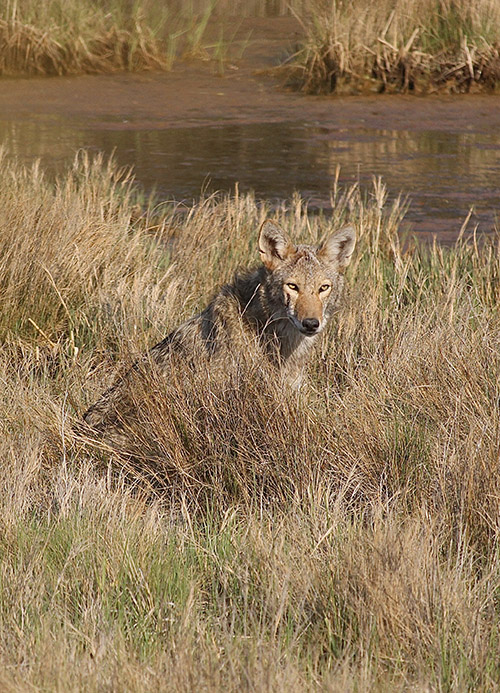By James FitzPatrick
Contributing Writer
If you pay close attention while walking in Corson’s Inlet State Park, you never know what you might find.
Abby Longstreet was in the park on April 21 when she had a surprising encounter.
“I was with my son and a friend out for our daily walk,” said Longstreet of Egg Harbor Township.
She likes to walk in the Ocean City nature reserve at least once a week, carrying the camera that her son, Evan Yoder, bought for her. It takes much better pictures than the smartphone she used to use for photography.
“Toward the end of our walk that day, my friend stopped and asked me, ‘What is that’?”

As she looked she saw something blending in with the marsh grass; then she saw its eyes.
“I zoomed in with my camera and could see the coyote looking back at us,” she said. “In that moment we actually weren’t sure if it was a coyote or a wolf, but it kept eye contact with us.”
According to the New Jersey Department of Environmental Protection, coyote sightings are not unusual. They’re common throughout New Jersey, said Larry Hajna, NJDEP spokesman.
They can be found in all types of environments – rural, suburban and urban. They play an important role in nature by keeping the rodent population under control. And they tend to steer clear of people.
“By nature, they are wary of people and will usually flee in the presence of humans,” he said.
Longstreet, who co-owns Creative Minds Insurance Agency in Northfield, said the Corson’s Inlet coyote did not seem to be afraid, nor did it run away.
“We got the feeling that we interrupted its peace. It did seem curious about us, but definitely very calm,” she said.
After checking out Longstreet, Yoder, and their friend, James Cook for a bit, it slowly walked away, stopping every few feet to turn and look back.
“Eventually it disappeared into the trees. The whole encounter probably lasted about two to three minutes tops,” she said.
They continued their walk with no fear that it would follow or approach them. On the way back they rechecked the location and the coyote was gone, having disappeared somewhere in the oceanfront dune forest that is Corson’s Inlet State Park.
The 341-acre nature reserve at the city’s southern tip is undeveloped and untouched, much like it was when the only human visitors were from the Leni-Lenape tribe.
It has been a state park since 1969, providing habitat for endangered or protected bird species including piping plovers, red knots, least terns, black skimmers, and American oystercatchers.
Shore Local called the park trying to find out whether coyotes pose a threat to the protected birds. No one was willing to talk on the record, other than to remind us that coyotes are part of the natural order of the Pine Barrens and that their presence is no surprise.
Prior to 1900, according to the Rutgers University Agricultural Extension, coyotes were only found in the prairies and deserts of central and western North America.
Logging and agricultural development, combined with a campaign to exterminate wolves from the eastern United States, created an opportunity for the coyote to expand its territory eastward.
Researchers have determined that what is known today as the eastern coyote contains DNA from the wolf, western coyote, and domestic dogs, according to Rutgers, the latter fact being one of the reasons why they are more docile than their western cousins.
The first documented sighting of an eastern coyote in New Jersey was in Hunterdon County in 1939, Rutgers said. It wasn’t until 1948 that the state’s first verified sighting occurred. It happened to be right here in Cape May County.
“Coyotes have been reported in 453 New Jersey municipalities (out of 564) covering 96 percent of the state’s land area,” Rutgers reports. “Because coyotes are so elusive, it is difficult to estimate their population size in New Jersey, but they likely number in the thousands.”
According to the New Jersey Conservation Foundation, eastern coyotes have distinctive features that distinguish them from foxes.
“One easy way to identify eastern coyotes is by their drooping, bushy, black-tipped tails, often seen tucked between their hind legs. They also have large, pointed ears and bright yellow eyes,” NJCF reports on its website. “Red foxes, in contrast, are smaller and distinctive for their black ‘socks’ and ear tips, and white tips on their tails. Gray foxes are even smaller, and rarely glimpsed outside densely forested areas.”
Even when wildlife is hidden from view, there are ways to get close and observe without intruding. That’s why Longstreet is glad she graduated from her phone to a camera that lets her get close while keeping a comfortable distance.
“Getting too close to an unknown wild animal might be tempting, but can feel like a threat and cause the animal to act in a way it wouldn’t normally, or think fight or flight,” she said. “If you can’t enjoy observing at a distance, I would say to get a camera with a good zoom lens.”
Copyeditor and Contributing Writer James FitzPatrick has been a community journalist in Atlantic and Cape May counties for more than 30 years, including 20 years as editor of The Current Newspapers. He lives in Hammonton.









